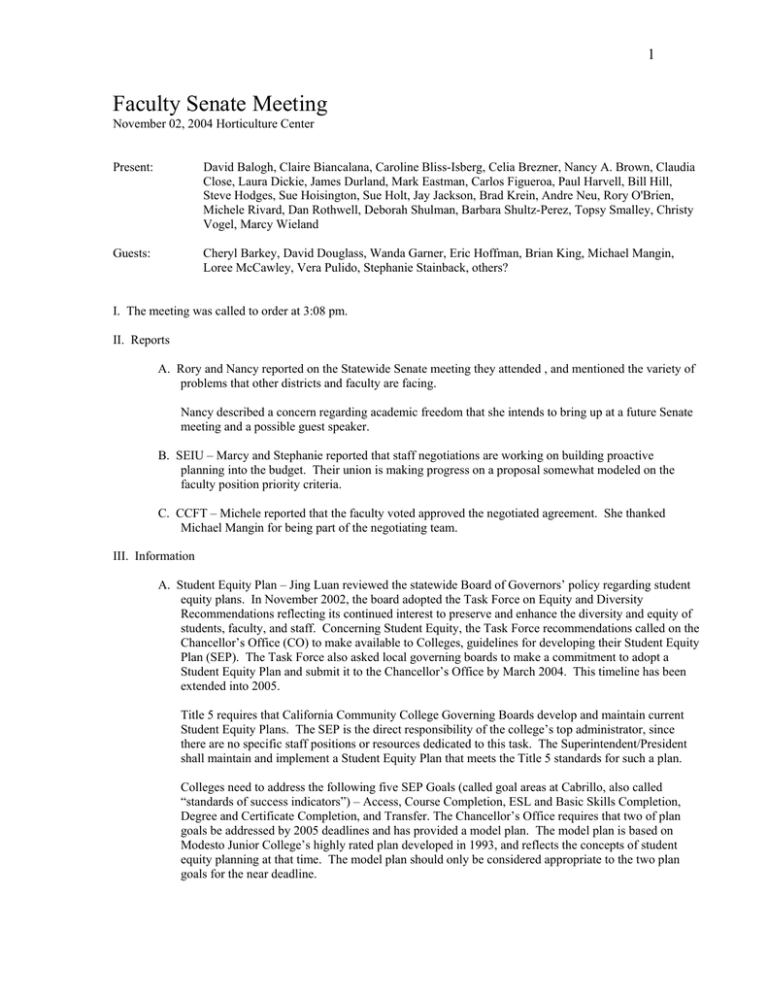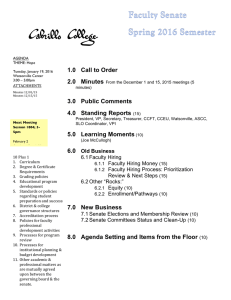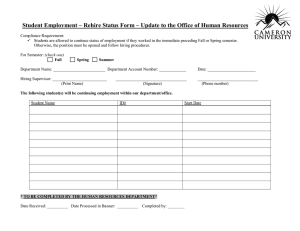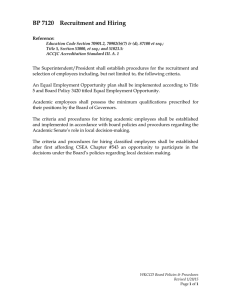Faculty Senate Meeting 1
advertisement

1 Faculty Senate Meeting November 02, 2004 Horticulture Center Present: David Balogh, Claire Biancalana, Caroline Bliss-Isberg, Celia Brezner, Nancy A. Brown, Claudia Close, Laura Dickie, James Durland, Mark Eastman, Carlos Figueroa, Paul Harvell, Bill Hill, Steve Hodges, Sue Hoisington, Sue Holt, Jay Jackson, Brad Krein, Andre Neu, Rory O'Brien, Michele Rivard, Dan Rothwell, Deborah Shulman, Barbara Shultz-Perez, Topsy Smalley, Christy Vogel, Marcy Wieland Guests: Cheryl Barkey, David Douglass, Wanda Garner, Eric Hoffman, Brian King, Michael Mangin, Loree McCawley, Vera Pulido, Stephanie Stainback, others? I. The meeting was called to order at 3:08 pm. II. Reports A. Rory and Nancy reported on the Statewide Senate meeting they attended , and mentioned the variety of problems that other districts and faculty are facing. Nancy described a concern regarding academic freedom that she intends to bring up at a future Senate meeting and a possible guest speaker. B. SEIU – Marcy and Stephanie reported that staff negotiations are working on building proactive planning into the budget. Their union is making progress on a proposal somewhat modeled on the faculty position priority criteria. C. CCFT – Michele reported that the faculty voted approved the negotiated agreement. She thanked Michael Mangin for being part of the negotiating team. III. Information A. Student Equity Plan – Jing Luan reviewed the statewide Board of Governors’ policy regarding student equity plans. In November 2002, the board adopted the Task Force on Equity and Diversity Recommendations reflecting its continued interest to preserve and enhance the diversity and equity of students, faculty, and staff. Concerning Student Equity, the Task Force recommendations called on the Chancellor’s Office (CO) to make available to Colleges, guidelines for developing their Student Equity Plan (SEP). The Task Force also asked local governing boards to make a commitment to adopt a Student Equity Plan and submit it to the Chancellor’s Office by March 2004. This timeline has been extended into 2005. Title 5 requires that California Community College Governing Boards develop and maintain current Student Equity Plans. The SEP is the direct responsibility of the college’s top administrator, since there are no specific staff positions or resources dedicated to this task. The Superintendent/President shall maintain and implement a Student Equity Plan that meets the Title 5 standards for such a plan. Colleges need to address the following five SEP Goals (called goal areas at Cabrillo, also called “standards of success indicators”) – Access, Course Completion, ESL and Basic Skills Completion, Degree and Certificate Completion, and Transfer. The Chancellor’s Office requires that two of plan goals be addressed by 2005 deadlines and has provided a model plan. The model plan is based on Modesto Junior College’s highly rated plan developed in 1993, and reflects the concepts of student equity planning at that time. The model plan should only be considered appropriate to the two plan goals for the near deadline. 2 Cabrillo’s first SEP was developed in 1995 (on file). In 1997, Cabrillo updated this document and presented to the governing board (on file). In addition, the Statewide Faculty Senate has a framing paper “Student Equity: Guidelines for Developing a Plan” (on file). Jing identified the members of Cabrillo’s SEP committee, including senators Jay Jackson and Andre Neu. Committee members have been assigned to individual goal areas. The committee has agreed upon a standard for determining disparity using the EEOC’s 80/20 rule. The draft plan will be disseminated to various governance groups in November. Dave asked that the Senate receive a copy then. The governing board will receive its first reading in December. The governing board will consider approving the report in January. If approved, the report will be submitted to the Chancellor’s Office by the deadline, January 31, 2005. B. Diversity and Faculty Hiring – Brian King expressed his interests in the hiring process and facilitating the search for top candidates. He was excited by the challenge finding men and women to sustain the tradition of excellence at Cabrillo. The new hires planned for this spring will account for roughly ten percent of our faculty. Meanwhile county and student demographics are changing rapidly. Hiring committees are forming, and he has met with one already. He views this first meeting is a great opportunity to discuss how to get an outstanding pool of candidates and select an outstanding group of new faculty. Brian then brought up several issues for discussion, included diversity, merit, enthusiasm, and ranked vs. unranked lists. He will conduct a workshop , “Training on Legal Issues and Diversity in Recruiting, Selection and Hiring,” on November 16, from 9 to noon, for the management team (with goal of 100% participation for the management group). The same program will be offered on February 2 and 3 during Flex Week for faculty and staff (with participation strongly encouraged for anyone who is serving on a hiring committee). Carmen Plaza de Jennings will be the facilitator. Topsy addressed the importance of enlarging the pool of candidates and promised to provide more information on ways to do this at the next Senate meeting. Senators discussed how adjunct faculty face advantages and disadvantages in the hiring process. Their strengths are well known and committee members’ sympathy for their interests can help their cases. Conversely, their weaknesses are well known, whereas the strengths of unfamiliar candidates may seem less compromised. The discussion turned to the role of the teaching performance in the interview. Laura said we should make sure that the candidate’s experience is factored in more than enthusiasm. Brian responded that experience doesn’t necessarily mean that you’re the best candidate. He raised the question of cases where some candidates have merit while others have enthusiasm. Brian then addressed the issue of ranked vs. unranked lists. He mentioned that faculty and administration can have different views on hiring. He stressed that his proposal for unranked lists is unofficial and that he was interested in beginning a discussion and exploring the idea. Cabrillo policy is for hiring committees to be free to submit ranked lists. In Cabrillo’s experience, hiring committees sometimes submit unranked lists when the committee is very divided over the top candidates. Bill asked about defining diversity and our institutional priorities. Brian responded by identifying those diversity factors that are obvious (e.g., gender, ethnicity, age) but stated that there are many ways to diversify. He stressed that the training should address what we can and can’t talk about in the hiring process. What is diversity? Discussions have occurred but diversity is not an easy aspect to assess. Some people have overcome different difficulties in life. 3 The discussion turned to candidates’ applications. Sometimes, through no fault of their own, a candidate may be missing a letter of recommendation. Under what conditions may a committee consider a incomplete application? Nancy reported that the Student Senate is interested in having a more active role. Their interest must be meshed with the Ed Code. The ASCC president will compile a slate of students as candidates (among other students) to serve on hiring committees. Dave asked for clarification about whether a retired faculty member might serve, at a later date, as a community representative on a hiring committee in his/her field. Claire responded that this can occur, as long as the retiree is from a different field. C. Diversity Subcommittee – James Durland reported on the Diversity Subcommittee’s recommendations regarding issues of diversity and hiring. These are: 1) all aspects of the hiring process must be legal and inclusive 2) Hiring committees will form early and be involved in creation of the job announcement, development of the interview questions, clarification of the role of HR in screening applications, and participation in recruitment efforts. 3) Hiring/diversity training for committee members will include a Flex activity, development of job announcements, legal responsibilities, screening techniques, recruitment methods, advertising methods, alternative approaches to the interview process, issues of diversity and bias, and the final selection process. 4) Refining and updating the screening/hiring guidelines in AR 5105, with the development of a handbook with guidelines for all elements of hiring and diversity issues. 5) The creation of a temporary Faculty Position to assist the President, HR, and committees known as: Faculty Diversity Coordinator. Vera’s presentation on ‘power hiring’ was mentioned. The distinction was made between the desired skills that a hire can acquire on-the-job vs. those that a hire should already possess. Faculty need to be responsible in assisting new faculty members through the rough spots. V. Rory addressed topics for the next agenda. The meeting adjourned at 5:05 pm.


